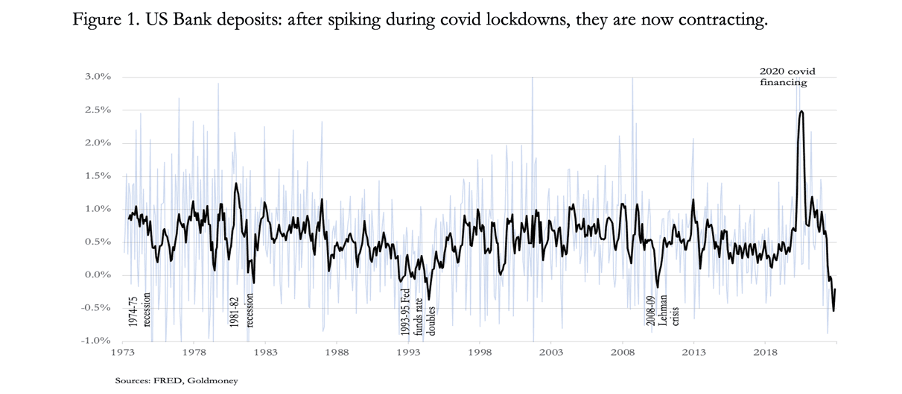According to an article in Bloomberg on November 5, 2019, Milton Friedman’s plucking theory seems to be vindicated. According to Friedman there appears to be no systematic connection between the size of an economic expansion and the succeeding economic contraction.
A large contraction in output tends to be followed on the average by a large business expansion. A mild contraction, by a mild expansion (Economic Inquiry , April 1993, 171-77).
The Bloomberg article refers to a study by Tara Sinclair that employs advance mathematical techniques that supposedly confirmed Friedman’s hypothesis that in the US bigger recessions are followed by faster recoveries – but not the other way around. According to Bloomberg some other researchers found similar results for other countries.
On this way of thinking, views such as those presented by Ludwig von Mises that the magnitude of an economic bust is because of the magnitudes of the previous boom is false.
Contrary to Mises then bust is caused by various mysterious factors that have nothing to do with the previous boom. We suggest that the main problem with the Friedman’s model is the lack of coherent definition of what a boom-bust cycle is all about.
Defining boom-bust cycles
In a free, unhampered market, we could envisage that the economy would be subject to various shocks but it is difficult to envisage a phenomenon of recurrent boom-bust cycles. According to Rothbard,
Before the Industrial Revolution in approximately the late 18th century, there were no regularly recurring booms and depressions. There would be a sudden economic crisis whenever some king made war or confiscated the property of his subjects; but there was no sign of the peculiarly modern phenomena of general and fairly regular swings in business fortunes, of expansions and contractions.[1]
The boom-bust cycle phenomenon is somehow linked to the modern world. But what is the link? We suggest that the source of the recurring boom-bust cycles turns out to be the alleged “protector” of the economy — the central bank itself. A loose central bank monetary policy, which results in an expansion of money out of “thin air” sets in motion an exchange of nothing for something, which amounts to a diversion of real wealth from wealth-generating activities to non-wealth-generating activities. In the process, this diversion weakens wealth generators, and this in turn weakens their ability to grow the overall pool of real wealth.
The expansion in activities that are based on loose monetary policy is what an economic “boom” (or false economic prosperity) is all about. Note that once the central bank’s pace of monetary expansion strengthens the pace of the diversion of real wealth is also going to strengthen.
Once however, the central bank tightens its monetary stance, this slows down the diversion of real wealth from wealth producers to non-wealth producers. Activities that sprang up on the back of the previous loose monetary policy are now getting less support from the money supply; they fall into trouble — an economic bust or recession emerges.
Contrary to Friedman it is not possible to have an economic bust without the emergence of the previous boom. Again the subject matter of boom-bust cycles are various activities that emerged on the back of central bank policies. These activities, which we label as bubble activities, are preceded by monetary policies of the central bank, which in turn tends to manifest itself by means of the yearly growth of money supply and the height of interest rates.
Loose monetary policies are likely to manifest in the strengthening of the annual growth of money supply and a decline in the policy interest rate. A tighter monetary stance is likely to manifest in the decline in the annual growth of money supply and in the increase in the policy interest rate.
Again, a loose monetary stance, and a subsequent increase in the momentum of money supply results in the increase in bubble activities whilst a tighter stance leads to their demise.
On this way of thinking an increase in bubbles cannot emerge during a tighter monetary stance. On the contrary, a tighter stance will lead to a demise of the bubbles. Obviously then it does not make much sense as the Friedman’s plucking model suggests that an economic boom is caused by the previous bust.
It seems that for Friedman economic boom is a strengthening in the momentum of real gross domestic product (GDP) whilst an economic bust is the weakening in the momentum of real GDP. Note that such definition does not separate between bubble and non-bubble activities and in this sense cannot tell us whether an economic expansion is on account of bubble activities or on account of real wealth generation.
So how then we are to respond to various sophisticated empirical studies, which support Friedman’s plucking theory?
We suggest that contrary to Friedman the data cannot talk by itself. We have to question the validity of Friedman’s theory, which implies that bubble activities emerge during an economic bust.
We have shown that bubbles are caused on account of loose monetary stance of the central bank. Whilst bust, or the demise of bubbles are in response to the tighter monetary policies of the central bank.
Hence, regardless of the sophistication of analysis if the underlying logic is flawed then the outcome of the analysis must be rejected.
[1] Rothbard The Austrian Theory of the Trade Cycle and other essays, The Mises Institute,1983.

